Let’s be honest—hair extensions can completely transform your look. Whether you’re after length, volume, or just a bit of added glamour, they’ve become the go-to beauty solution for a reason. But before diving head-first into the world of extensions, there’s one key question most of us forget to ask: what’s the actual hair extension lifespan—and how long do they really last?
The truth is, not all hair extensions are created equal—and neither is their lifespan. Some can keep you looking fabulous for months, while others are more of a short-term fix. So, if you’re wondering which type is worth the investment, whether you’re browsing online or visiting a trusted hair extension salon, we’re here to break it all down.
In this guide, we’ll walk you through the hair extension lifespan of every popular method out there, plus tips to make your extensions go the distance.
Why Does Hair Extension Lifespan Matter?
Before we get into the nitty-gritty of timelines, let’s talk about why lifespan even matters. Hair extensions aren’t just a quick beauty fix—they’re a financial investment, a commitment of your time, and often part of your daily hair routine.
Knowing the hair extension lifespan can help you:
- Budget wisely
- Set realistic maintenance expectations
- Choose a method that suits your lifestyle
- Avoid damage to your natural hair
After all, the last thing anyone wants is to splash out on a full head of extensions, only for them to become dry, tangled, or fall out within weeks.
What Affects the Lifespan of Hair Extensions?
It’s not just the type of extension that determines how long it lasts. Several factors come into play:
- Hair quality: Human hair extensions (especially Remy) tend to last much longer than synthetic ones.
- Application method: How they’re attached can affect how well they stay in place and how much wear and tear they endure.
- Your haircare routine: Heat styling, product build-up, and even sleeping with wet hair can all shorten their lifespan.
- Lifestyle: Swimming, exercise, and frequent washing can also take their toll.
With all that in mind, let’s take a closer look at how long each type really lasts.
Clip-In Extensions
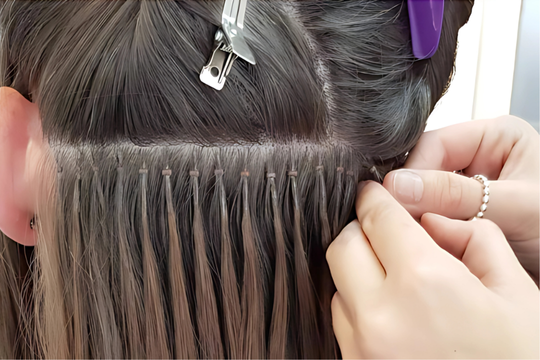
Hair Extension Lifespan: 6 months to 1 year (or more)
Clip-ins are the ultimate in flexibility. You simply pop them in when you want a bit of extra volume or length, and take them out before bed. Since you’re not wearing them daily, they tend to last longer than permanent options—as long as you treat them well.
Pros:
- No commitment
- Easy to apply and remove
- Least damaging to natural hair

Cons:
- Not ideal for everyday wear
- Can look bulky if not applied properly
Top Tip: Store your clip-ins in a silk or satin bag and brush them gently after each use. If you only wear them occasionally, they could last well over a year.
Tape-In Extensions
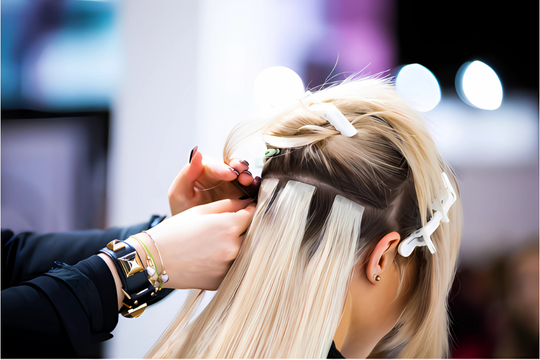
Hair Extension Lifespan: 6 to 8 weeks per application, up to 6-9 months with proper care
Tape-ins are semi-permanent and one of the most popular professional methods. They lie flat against your head, offering a seamless blend—especially for those with fine hair. While the adhesive typically holds for 6–8 weeks, the hair itself can be reused multiple times with professional re-taping.
Pros:
- Natural-looking and lightweight
- Quick to apply
- Reusable

Cons:
- Requires maintenance every 6–8 weeks
- Avoid oil-based products near the tape
Top Tip: Avoid applying conditioner or oils near the roots, as they can cause the tape to slip. If looked after properly, your tape-ins can serve you well for up to 9 months.
Nano Ring and Micro Ring Extensions
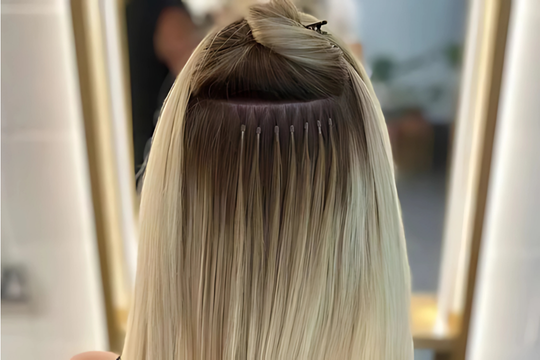
Hair Extension Lifespan: 6 to 8 weeks per fitting, up to 9–12 months overall
These tiny rings are clamped to your natural hair, holding the extension strand in place without glue or heat. The rings are discreet and perfect for those wanting long-lasting results with less chemical involvement.
Pros:
- No glue, heat, or tape
- Reusable hair
- Great for long-term wear

Cons:
- Can be uncomfortable at first
- Rings may be visible on very fine hair
Top Tip: Book maintenance appointments every 6–8 weeks to shift the rings back up, as they grow out with your natural hair. With good care, the hair itself can last close to a year.
Fusion (Keratin Bond) Extensions
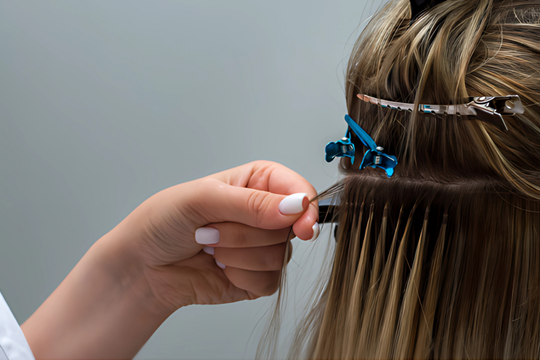
Hair Extension Lifespan: 4 to 6 months
Fusion bond hair extensions are applied using a heat tool that bonds the keratin tip to your natural hair. This method offers one of the most natural-looking results, and the bonds are virtually invisible.
Pros:
- Long-lasting
- Very secure and discreet
- Ideal for thicker hair

Cons:
- Not reusable
- Takes hours to apply and remove
- May cause damage if not removed correctly
Top Tip: Avoid oily or silicone-based products near the bonds, as they can cause them to weaken. Although the extensions aren’t reusable, they’ll keep their look for up to 6 months if cared for properly.
Sew-In (Weave) Extensions
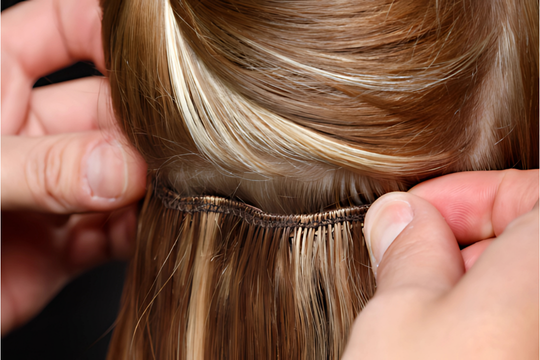
Hair Extension Lifespan: 6 to 8 weeks per install, up to 6–9 months for the hair
Sew-ins are often chosen by those with textured or thicker hair. Your natural hair is braided into cornrows, and the extensions are sewn in using a needle and thread. They’re durable and secure, making them a favourite for anyone seeking a long-term style.
Pros:
- Secure and great for active lifestyles
- Works well for thick or curly hair
- Hair can be reused

Cons:
- Can be heavy
- May cause tension or breakage if worn too long
Top Tip: Let your scalp breathe between installs and avoid keeping a sew-in for more than two months. Regular cleansing and scalp care are essential.
Halo Extensions
Hair Extension Lifespan: Up to 1 year or more
Think of halo extensions as the low-maintenance cousin of clip-ins. These one-piece extensions sit on your head with a clear wire—no clips, glue, or hassle. Perfect for quick styling and zero commitment.
Pros:
- Easiest to apply
- Very gentle on natural hair
- Long-lasting with minimal wear
Cons:
- Not suitable for up-dos or high ponytails
- Limited styling flexibility
Top Tip: Don’t over-wash your halo extension—once every 10–15 wears should do the trick. Always use sulphate-free shampoo and heat protectant when styling.
Synthetic Hair Extensions
Hair Extension Lifespan: 1 to 3 months
Let’s not forget synthetic options. While they’re more affordable and come in loads of colours and textures, they don’t have the longevity or natural look of human hair. They also can’t withstand heat styling (unless labelled “heat resistant”).
Pros:
- Budget-friendly
- Fun for occasional wear
- Low-maintenance
Cons:
- Short lifespan
- Cannot be heat-styled (in most cases)
- May look less natural
Top Tip: If you’re only after a temporary change for an event or photoshoot, synthetic hair can be a great option. Just don’t expect it to go the distance.
How to Extend Your Hair Extension Lifespan
No matter which type you choose, how you care for your extensions will make all the difference. Whether you’ve bought them from a salon or a trusted hair extension supplier, proper maintenance is key to keeping them looking their best. Here are some simple habits that can seriously stretch their life:
- Brush gently: Use a soft-bristle brush or a wide-tooth comb and start from the ends, working upwards.
- Use the right products: Avoid sulphates, alcohols, and heavy oils.
- Wash less frequently: Unless you’re sweating loads, you don’t need to wash your extensions as often as your natural hair.
- Avoid sleeping with wet hair: This can lead to tangling, matting, and breakage.
Tie your hair up at night: Use a loose braid or silk wrap to prevent knots and frizz.
Choosing the Right Extension for You
When it comes to picking the best type of extension, your lifestyle, budget, and hair goals should guide your decision—not just the hair extension lifespan.
If you love the idea of changing up your look now and then, clip-ins or halo extensions could be perfect. If you’re after something more long-term with minimal daily effort, tape-ins or nano rings might be the way to go. For special occasions or full transformations, fusion or sew-ins offer that wow factor—but remember, they’ll need more commitment.
At the end of the day, all hair extensions require care and maintenance. But with the right method and a solid routine, you can keep them looking lush and lovely for as long as possible.
Ready for new hair without the guesswork?
Now that you know how each method stacks up in terms of hair extension lifespan, you’re one step closer to finding the perfect match for your needs—and making sure your investment lasts.
FAQ
What type of hair extensions last the longest?
Generally, nano ring and micro ring extensions offer one of the longest lifespans, often lasting 9 to 12 months with proper care and regular maintenance appointments. The actual bonds may need adjusting every 6–8 weeks, but the hair itself can be reused multiple times.
Can I make my hair extensions last longer?
Definitely! Gentle brushing, avoiding sulphate shampoos, using heat protectant when styling, and tying your hair up before bed can all help prolong the hair extension lifespan. Regular salon maintenance is also key, especially if you’ve chosen a more permanent method.
Are human hair extensions better than synthetic ones?
Yes—human hair extensions, particularly Remy hair, are far more durable and natural-looking than synthetic options. They can be heat-styled, washed, and reused for months, whereas synthetic extensions usually last just 1 to 3 months and are more limited in styling options.
How often should I visit a hair extension salon?
It depends on the type of extensions you have. Semi-permanent methods like tape-ins or nano rings typically require touch-ups every 6 to 8 weeks. If you want to keep your hair looking seamless and healthy, regular visits to a professional hair extension salon are a must.
How do I know when it's time to replace my extensions?
If your extensions are becoming dry, tangled, or difficult to manage—even after proper care—it’s probably time to replace them. For reusable methods, like nano rings or sew-ins, the hair can often be reinstalled, but worn-out strands will eventually need upgrading.
Will extensions damage my natural hair?
Not if they’re applied correctly and cared for properly. Choosing a reputable hair extension salon and following your stylist’s aftercare advice can greatly reduce the risk of damage. Avoiding overuse of heat tools and keeping your scalp healthy will also help.

